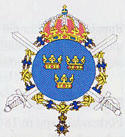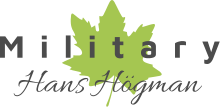

Copyright © Hans Högman 2019-05-20
Swedish Regiments of the
Allotment System - Cavalry (1)
Cavalry Regiments:
2. Swedish Regiments -
Cavalry (1)

The term "cavalry" wasn't in use until around the
1650's. In Sweden the cavalry was called "rytteriet"
(the riders or the horsemen) prior to that time. For
example Smålands ryttare and Upplands ryttare
(ryttare = horsemen).
The Cavalry or "rytteriet" was units who fought on
horsebacks.
There are several types of cavalry:
•
Dragoons: Dragoon was formerly mounted
infantry. They traveled on horseback to the
battlefield but they fought as foot soldiers. As
mounted infantry they were very mobile units. It
happened that dragoons fought as cavalry in
battles. However, this was a type of warfare they
weren't trained for and could end up in disaster.
An example of a battle where dragoons
successfully were used as cavalry was the battle
of Lund in 1676.
During the 18th century the dragoons were
more and more used as cavalry and therefore
also trained as cavalry. Finally it was only the
name that separated them from the light
cavalry. During the 19th century dragoons was a
term for heavy cavalry.
•
Hussars: Hussars was first a term for The
Hungarian heavy cavalry. Hussar regiments were
established in Sweden during the 1700's. They
were armed with sabers and carbines (short
rifles). The Hussars wore dolma until the 1870's
when the attila was in use as a tunic.
•
Cuirassiers: The Cuirassiers were the heavy
cavalry. The name originates from cuirass which
was the name of the armored protection they
wore.
During the 17th century it became too ungainly
(too awkward) to wear a full cuirass. Instead a
light cuirass came into use plus a helmet instead
of the older full head protection. The cuirassiers
were armed with a rapier (sword) and a
handgun.
Fully equipped cuirassiers were quite heavy so
they needed large horses to carry them.
During the 19th century the cuirassier regiments
didn't differ from other cavalry.
•
Lancers: A lancer was a type of cavalryman who
fought with a lance. The weapon was widely
used in Asia and Europe during the Middle Ages
and the Renaissance by armored cavalry, before
being adopted by light cavalry. Lancers typically
wore a double-breasted jacket.
The tactical unit used by the cavalry was the
squadron. A cavalry regiment of 1,000 men was
organized into four squadrons of 250 horsemen
each.
The squadrons were organized into two companies
of 125 men each.
The cavalry had a very important role in the battles
during the Middle Ages. During the 1500's the cavalry
became less important in battles due to the use of
firearms. The cuirass gave of good protection against
arrows but not against bullets.
The Swedish king, Gustav II Adolf, restored the
importance of the cavalry in the beginning of the
17th century. He introduced a new battle tactic for
the cavalry. In the new tactic the cavalry was to
charge with the swords ready in their hands. In
central Europe the cavalry still used the so-called "
karakolering" where the horsemen charged with their
handguns. After the handgun had been fired they
returned back to their own lines.
King Gustav II Adolf had his horsemen to continue
the attack after firing the handguns, however now
with the swords as weapons.
King Karl II had this tactic further refined and called it
a "cavalry charge with edged arms" (swords)
"kavallerichock med blanka vapen".
This tactic made the Swedish cavalry very feared
during the Great Nordic War (1700 - 1721). The most
important weapon of the Carloean (warriors of King
Karl) horseman was the sword ("värja"). The sword
was straight rapier. It was a perfect weapon for both
cutting as well as thrusting.
Later, when fine caliber handguns was introduced
and when machineguns came into use the cavalry
disappeared from the battlefields. Cavalry had no
place in the new modern warfare and World War I
was the last war with horsemen in action.
The cavalry unit codes begin with letter “k” followed
by a number; for example, K1 (1st Cavalry Regiment).
Swedish name: Adelsfanan
The history of the unit goes back to the very old duty
of the Nobility to keep horsemen in order to defend
the country when needed. This system was called
"adelns rusttjänst" and was introduced in 1280.
The name of the unit, the Cavalry Corps of the
Nobility (Adelsfanan) wasn't in use until 1571. A
“fana” was a 16th century name for a unit of cavalry.
A fana consisted of 300 cavalrymen.
When the Swedish Army units were organized into
regiments in the beginning of the 17th century they
were given regimental names. However, the
"Adelsfanan" kept their old name.
All officers in the Cavalry Corps of the Nobility were of
noble birth. The regiment was an enlisted (värvad)
unit.
The regiment was disestablished in 1809.
During the regime of King Gustav II Adolf (1611 -
1632) the Cavalry Corps of the Nobility was
organized into 4 companies. Three of those were
organized in Sweden and one in Finland. A 5th
company was established in Sweden in 1640.
In 1658, when the province of Skåne became
Swedish a 6th company was established in this
province.
Prior to the New Allotment System (1682) the Cavalry
Corps of the Nobility numbered 550 cavalrymen
organized into 6 companies.
Names of the Companies making up the
Regiment:
Sweden: Uppland Company, Västgöta Company,
Södermanland Company, Östgöta Company and
Scanian Company. The company names are names
of Swedish provinces.
Finland: Lieutenant Colonel's Company (established
in the counties of Åbo and Björneborg.
The horsemen were recruited only in times of war
and according to the privileges of the Nobility this
unit was only to serve within Sweden.
However, in 1702, King Karl XII had the Swedish
companies shipped to the Baltic provinces.
The Cavalry Corps of the Nobility participated in the
battles of Lund 1676, Fraustadt 1706 and ended up
as Russian prisoners of War after the battle of
Poltava 1709 when the Swedish Field Army
surrendered in Perevolotjna a week after the battle.
The Cavalry Corps of the Nobility had their last
General Muster in 1743. The unit was never
mobilized after that year. The regiment was finally
disestablished in 1809.
Companies:
1.
Life Company (Uppland, Västmanland, Dalarna
and Norrland)
2.
Major’s Company (Västergötland and Bohuslän)
3.
Lieutenant Colonel’s Company (Finnish
Company)
4.
Östgöta and Småland Company
5.
Södermanland Company (Södermanland, Närke
and Värmland)
6.
Skåne Company (Skåne, Halland, Blekinge)
Swedish name: Livgardet till
häst, K1
The regiment was first established
in 1770 as the Finnish Light
Dragoon Corps (Finska lätta
dragonkåren). The regiment was an enlisted
regiment.
The regiment received the name Light Dragoons of the
Life Regiment (Lätta dragonerna av Livgardet) in 1772.
In 1793 the regiment received the name Life Hussar
Regiment (Livhusarregementet) and in 1797 Light
Dragoon Regiment (Lätta Livdragonregementet).
In 1806 the regiment carried the name Mounted
Life Guards (Livgardet till häst, K1).
In 1806 the regiment was organized as hussars, in
1845 dragoons, in 1852 lancers and in 1879 once
again dragoons.
The regiment was disestablished in 1927. In this year
the Life Regiment Dragoons (K2) and the Mounted Life
Guards (K1) were merged. The new regiment
received the name Mounted Life Regiment
(Livregementet till häst, K1).
In 1949 the regiment received the name the Life
Guard Squadron (LivgardesSquadronen) and in 1975
the Life Guard Dragoons (Livgardets dragoner).
The regiment was disestablished in 1984. After 1984
the K1 is a cavalry battalion within the Svea Life
Guards.
The regiment's history goes back to the units that
were established in the border provinces facing
Russia in the southeast of Finland (Finland was a
Swedish region until 1809). In order to strengthen
the defense of those border areas, especially along
River Kymmene, an enlisted dragoon corps was
established in the county of Nyland in 1770. The
corps was first organized into 3 squadrons of 50 man
each and the unit received the name the Finnish Light
Dragoon Corps (Finska lätta dragonkåren).
In order to get experienced soldiers into the Finnish
Corps many soldiers were transferred from a
Swedish Hussar regiment in Pomerania, Northern
Germany (Svenska Pommern) to the regiment.
The Finnish Light Dragoon Corps was at first based in
Borgå, Finland. In command of the corps was, at that
time, Colonel Jacob Magnus Sprengtporten.
Colonel Sprengtporten was one of King Gustav III
promoters to the King’s coup d'état (statskupp) in 1772.
King Gustav III now got a total control of the regime
of Sweden.
Colonel Sprengtporten secured Finland by taking
control of Sveaborg fortress outside Helsinki. No unit
in Finland could thereby be a threat to the King.
Once the Sveaborg fortress was in control by
Sprengtporten he was supposed to ship a unit to
Stockholm to support the King’s coup d'état.
However, due to bad weather, the force didn’t arrive
in time for the coup d'état. His force sent to
Stockholm numbered 1,000 soldiers, among them 2
dismounted squadrons from the Finnish Light
Dragoon Corps.
The King promoted Sprengtporten to Lieutenant
Colonel in gratitude to his support and loyalty.
The Finnish Light Dragoon Corps got the rank of
Royal Gurads and received the name Light Dragoon
Corps of His Majesty’s Life and Hussar Troops (Lätta
dragonkåren av Konungens Liv- och Hustrupper).
However, the corps was referred to as The Light
Dragoons of the Life Guards (Lätta dragonerna av
livgardet).
The unit was reorganized into 5 squadrons of 50
men each. Two of the squadrons were based in
Stockholm and three in Finland.
The entire unit was garrisoned in Stockholm in 1777.
Two of the three Finnish squadrons were transferred
to Stockholm while the third squadrons was
consolidated with the Karelian Dragoons. The four
Swedish squadrons were quartered in the cities of
Enköping, Sigtuna and Södertälje. At this time Baron
Ewert Taube was in command of the unit.
In 1793 the entire unit was once again quartered in
Stockholm.
In 1797 the unit received the name Light Life
Dragoon Regiment (Lätta livdragonregementet) and
in 1806 Mounted Life Guards (Livgardet till häst).
The regiment was enlisted and numbered 1505
cavalrymen.
Location of the primary Garrison of the
Regiment: From 1770 Borgå (Finland), 1793
Hantverkargatan 45, Stockholm, from 1811 Storgatan
35-49 and from 1897 barracks at Lidingövägen 28.
Swedish name: Livregementet
till häst (Upplands ryttare), K2
The regiment was first established in
1626 as the Uppland Horsemen
(Upplands ryttare). The regiment was
linked to the Allotment System in 1687.
The regiment received the name Mounted Life
Regiment (Livregementet till häst) in 1667. In 1791 the
regiment received the name Cuirassier Corps of the
Life Regiment Brigade (Livregementsbrigadens
kyrassiärkår) and in 1815 the Dragoon Corps of the
Life Regiment (Livregementet dragonkår).
In 1892 the regiment carried the name the Life
Regiment Dragoons (Livregementets dragoner,
K2).
The regiment was reorganized into an enlisted
regiment in 1901. The regiment was allotted prior to
this year.
The regiment was disestablished in 1927. In this year
the Life Regiment Dragoons (K2) and the Mounted Life
Guards (K1) were merged. The new regiment
received the name the Mounted Life Regiment
(Livregementet till häst, K1).
The regiment's history goes back to the "fanor" that
was raised in the provinces of Uppland and
Södermanland in 1536.
Those "fanor" were merged in 1608 into the
Södermanland Horsemen (Södermanlands fanan
eller Södermanlands ryttare). The horsemen were
recruited in the provinces of Södermanland, Närke,
Västmanland plus Valla och Vadsbo districts of the
province of Västergötland.
In 1621 the unit was divided into two companies of
125 men each. One of the companies was the
Södermanland Company.
In 1623 the horsemen in the province of Uppland
was organized into 3 companies of 125 men each.
As a result of the Constitution adopted in 1634 the
Army was reorganized. The Södermanland
Horsemen was then disestablished and the
horsemen were transferred to the Östgöta Cavalry
Regiment. The horsemen in the provinces of Närke
and Värmland plus the Västgöta horsemen of the
Södermanland horsemen were transferred to the
Uppland Horsemen.
The Södermanland Horsemen, now serving in the
Östgöta Cavalry Regiment, was in 1638 transferred to
the Uppland Horsemen.
The Uppland Horsemen was at that time organized
into 8 companies.
In 1667 the regiment was awarded the status of Life
Regiment and received the name His Majesty's
Mounted Life Regiment (Konungens Livregementet till
häst).
In 1674 the regiment was extended and now formed
12 companies of 150 men each, in total 1800
cavalrymen.
Nils Bielke was in command of the regiment in 1667.
After the victorious Battle of Lund in 1676 the
regiment was awarded for its bravery. The King Karl
XI made the comment after the battle: "Next to God
I'm in great gratitude to Nils Bielke and his brave Life
Regiment".
During the Swedish-Danish War of 1677 - 1679 the
regiment was extended to 17 companies. After the
war the regiment was reduced to 12 regiments.
Four of the companies were located within the
province of Uppland, three within Västmanland,
three in Närke, one in Södermanland and one in
Västergötland, in total 1505 cavalrymen.
Names of the Companies making up the
Regiment: Life Company, Lieutenant Colonel's
Company, Major's Company, Östra Västmanland
Company, Östra Närke Company, Södermanland
Company, Roslags Company, Örebro Company,
Fellingsbro Company, Kungsör Company, Vadsbo
Company and North Uppland Company.
In 1785 a special unit of light dragoons was
established at the regiment. Eighteen cavalrymen
from each of the regiment's companies were
transferred to the new unit who formed 4 companies
of 36 men each. The dragoon unit was later
extended and during the Swedish - Russian War 1788
- 1790 the unit served as an independent unit and
formed 6 companies of 300 men. This unit received
the name Light Dragoon Corps of His Majesty's Life
Regiment (Lätta Dragonkåren av Kungl. Maj:ts
Livregemente).
The names of the Companies making up the
Corps: Dragoon Life Company, Uppland Company
and North-, South-, East- and West Company.
Prior to 1901 the Mounted Life Regiment was the
only regiment not being enlisted in the Stockholm
garrison. The regiment was then an allotted
regiment.
In 1791 the Mounted Life Regiment (Livregementet
till häst) was converted into a brigade and divided
into three corps:
1.
Cuirassier Corps of the Life Regiment Brigade
(Livregementsbrigadens kyrassiärkår)
2.
Hussar Corps of the Life Regiment Brigade
(Livregementsbrigadens lätta dragonkår)
3.
Light Infantry Battalion of the Life Regiment
Brigade (Livregementsbrigadens lätta
infanteribataljon)
The Cuirassier Corps of the Life Regiment Brigade later
became Life Regiment Dragoons (Livregementets
dragoner, K2). This Corps was formed by the
companies located around Stockholm.
The Hussar Corps of the Life Regiment Brigade later
became Life Regiment Hussars (Livregementets
husarer, K3).
The Light Infantry Battalion of the Life Regiment Brigade
later became Life Regiment Grenadiers
(Livregementets grenadjärer, I3).
The three corps of the brigade mentioned above
received a status of independent corps in 1815.
The Mounted Life Regiment was prior to 1791
allotted with 1505 "rusthåll".
Hence, the Regiment had 1505 cavalrymen
organized into 12 companies (3 battalions). After
1792 the regiment formed one battalion.
After 1815 the regiment carried the name the
Dragoon Corps of the Life Regiment (K2) and was
allotted with 505 "rusthåll". The county of Uppsala
had 279 "rusthåll" located within the county, the
county of Stockholm 221 and the county of
Gävleborg 5.
After 1833 the regiment formed 5 squadrons.
Location of the primary Garrison of the Mounted
Life Regiment: From 1881, Wiksberg, södra
Djurgården, Stockholm. Training camp: 1780 Utnäs
löt at Strömsholm, from 1815 Polacksbacken,
Uppsala and Ladugårdsgärde, Stockholm.
Squadrons, 1833:
1.
Life Squadron
2.
Sigtuna Squadron
3.
Roslags Squadron
4.
North Uppland Squadron
5.
Uppsala Squadron
Swedish name: Livregementets
husarer, K3
In 1791 the Mounted Life Regiment
(Livregementet till häst) was converted
into a brigade and divided into three
corps:
1.
Cuirassier Corps of the Life Regiment Brigade
(Livregementsbrigadens kyrassiärkår)
2.
Hussar Corps of the Life Regiment Brigade
(Livregementsbrigadens lätta dragonkår)
3.
Light Infantry Battalion of the Life Regiment
Brigade (Livregementsbrigadens lätta
infanteribataljon)
The Cuirassier Corps of the Life Regiment Brigade later
became Life Regiment Dragoons (Livregementets
dragoner, K2). This Corps was formed by the
companies located around Stockholm.
The Hussar Corps of the Life Regiment Brigade later
became Life Regiment Hussars (Livregementets
husarer, K3).
The Light Infantry Battalion of the Life Regiment Brigade
later became Life Regiment Grenadiers
(Livregementets grenadjärer, I3).
The three corps of the brigade mentioned above
received a status of independent corps in 1815.
The unit first received the name Light Dragoon Corps
of the Life Regiment Brigade (Livregementsbrigadens
lätta dragonkår) in 1791 and in 1796 Hussar Corps of
the Life Regiment Brigade (Livregementsbrigadens
husarkår).
In 1892 the regiment carried the name Life
Regiment Hussars (Livregementets husarer, K3).
In 1791 the unit was organized into 8 squadrons.
After 1815 the regiment was allotted with 500
"rusthåll". The county of Västmanland had 25
"rusthåll" located within the county, the county of
Örebro 335, the county of Södermanland 15 and the
county of Skaraborg 125.
In 1834 the number of squadrons were reduced to 5.
The names of the Companies making up the
Corps: Fellingsbro, Örebro, Östra Närkes, Västra
Närkes, Sanna, Arboga and Vadsbo squadrons. The
Östra Närkes suadron had 15 "rusthåll" in county of
Södermanland.
Location of the primary Garrison of the
Regiment: 1836 Örebro, from 1891 Skövde, from
1984 Karlsborg.
Training camp: From 1830 Utnäs löt and Axevalla
hed, from 1843 Sanna hed, Örebro, 1867 Axevalla
hed, 1881 Sanna hed Uppsala and Ladugårdsgärde,
Stockholm.
Squadrons 1834:
1.
Life Squadron (formerly Fellingsbro squadron)
2.
Örebro Squadron
3.
Östra Närkes Squadron
4.
Västra Närkes Squadron
5.
Vadsbo Squadron
Swedish name: Smålands
kavalleriregemente (Smålands
ryttare), K4
The regiment was first established in
1628 as the Småland Horsemen
(Smålands ryttare). The regiment was linked to the
Allotment System in 1695.
The regiment received the name Småland Cavalry
Regiment (Smålands kavalleriregemente) in 1684. In
1792 the regiment carried the name Småland Light
Cavalry Regiment (Smålands lätta kavalleriregemente)
and in 1802 Småland Light Dragoon Regiment
(Smålands lätta dragonregemente).
In 1808 the regiment received the name Småland
Dragoon Regiment (Småland dragonregemente).
The regiment was divided into two units in 1812.
The former 2nd Battalion of the regiment was
reorganized into infantry and received the name
Infantry Battalion of the Småland Dragoon Regiment
(Smålands dragonregementes infanteribataljon).
The former 1st Battalion of the regiment kept the
name "Småland Dragoon Regiment". However this
name was changed to the Småland Hussar
Regiment (Smålands husarregemente) in 1822.
The regiment was disestablished in 1927.
The regiment's history goes back to the "fanor" that
was raised in the counties of Kalmar and Kronoberg
(province of Småland) in 1543.
The regiment was allotted with 1000 "rusthåll".
Hence, the Regiment had 1000 cavalrymen organized
into 8 companies. All of the "rusthåll" were located
within the province of Småland.
After 1812, when the former cavalry regiment was
divided, the new dragoon regiment had 500
cavalrymen organized into 6 squadrons of 83 men
each. The county of Jönköping had 250 "rusthåll"
located within the county, the county Kalmar 138 and
the county of Kronoberg 112.
The regiment was organized into 5 squadrons in
1833.
Names of the Companies making up the
Regiment: Life Company, Lieutenant Colonel's
Company, Major's Company, Sunnerbo Company,
Växjö Company, Jönköping Company, Vetlanda
Company and Östra härads Company.
Location of the primary Garrison of the
Regiment: From 1906, Eksjö.
Training camp: From 1686 Ränneslätt, 1806
Qvarnarp, 1827 Ränneslätt.
Squadrons 1833:
1.
Life Squadron
2.
Södra Vedbo Squadron
3.
Vetlanda Squadron
4.
Ingelsta Squadron
5.
Staby Squadron
Infantry Battalion of the Småland Dragoon
Regiment:
After 1812, when the former cavalry regiment was
divided the 2nd battalion received the name Infantry
Battalion of the Småland Dragoon Regiment (Smålands
dragonregementes infanteribataljon).
In 1824 the name was changed to Småland
Grenadier Battalion (Smålands grenadjärbataljon,
I7).
The battalion was allotted with 500 "rotar".
Hence, the Regiment had 500 soldiers organized
into 4 companies. All of the "rotar" were located
within the counties of Jönköping (399 "rotar") and
Kronoberg (101 "rotar").
Companies 1833:
1.
Livkompaniet
2.
Östra Härads kompani
3.
Sunnerbo kompani
4.
Jönköpings kompani
Victorious Battle Campaigns (segernamn),
Småland Cavalry Regiment:
1.
Wallhof
1626
2.
Werben
1631
3.
Breitenfeldt 1631
4.
Lützen
1632
5.
Oldendorf
1633
6.
Wittstock
1636
7.
Golombo
1656
8.
Gnesen
1656
9.
Warschau
1656
10.
Fredriksodde 1657
11.
Bält
1658
12.
Lund
1676
13.
Landskrona 1677
14.
Klissow
1702
15.
Pultrusk
1703
16.
Warschau
1705
17.
Holowzin
1708
18.
Helsingborg 1710
19.
Svensksund 1790
Source: segernamn: Kungl. Smålands
Husarregementes Historia (Eksjö 1975)
Related Links
•
The Allotment System
•
Swedish Wars
•
The Navy & the Army Fleet
•
Swedish Military Unit Designations
•
Swedish Military Branch and Unit Insignias
•
Uniforms of the Swedish Army
•
Source References
Top of page
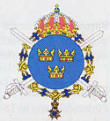
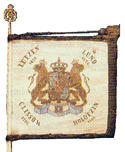

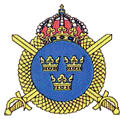
Cavalry Corps of the Nobility
Mounted Life Guards, K1
Mounted Life Regiment, K2
Life Regiment Hussars, K3
Småland Cavalry Regiment, K4










